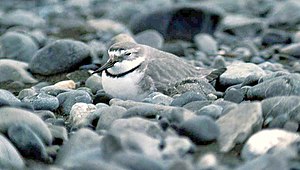Crooked beak
| Crooked beak | ||||||||||||
|---|---|---|---|---|---|---|---|---|---|---|---|---|

Brooding crooked beak ( Anarhynchus frontalis ) |
||||||||||||
| Systematics | ||||||||||||
|
||||||||||||
| Scientific name of the genus | ||||||||||||
| Anarhynchus | ||||||||||||
| Quoy & Gaimard , 1830 | ||||||||||||
| Scientific name of the species | ||||||||||||
| Anarhynchus frontalis | ||||||||||||
| Quoy & Gaimard, 1830 |
The crooked beak ( Anarhynchus frontalis ) is a species of bird in the plover family and is endemic to New Zealand . The crooked beak owes its name to its beak, which is almost always bent to the right. With this peculiarity, it belongs to the very few higher animal species that have an asymmetrical body appearance.
features
The crooked beak is 21 centimeters long and weighs 40 to 70 grams. In shape it resembles the Charadrius species. His neck is short and his body looks stocky. It has relatively long, broad wings and a short, wedge-shaped tail. The legs are short and have three toes ending in long claws. Its most striking feature is its beak, which is almost always curved to the right. It is also unusually long for a plover. Its wings, tail and back are slate gray with a slight shade of brown. The abdomen, chest and parts of the face are white. His head wears a dark gray cap. A black stripe runs from the beak, over the eyes and down to the neck. There is a black band on his chest, which is more clearly drawn in males than in females. Its beak, legs and the edges of the wings are black.
Way of life
The crooked beak eats insects (especially the larvae of mayflies ), worms and other invertebrates that it finds under stones. The female lays the two white to light gray, dark spotted eggs in a depression formed by body pressure on scree beaches or stony river banks, where they are well camouflaged between the stones and the dishes. If an enemy approaches, the brooding adult bird moves away from the nest, paralyzes its wings and thus distracts it from the eggs. If the enemy is far enough away from the nest, the adult bird flies up and returns to its eggs. The young are fleeing the nest , they leave the nest immediately after hatching. They are sexually mature after three years.
Distribution, Protection and Persistence
The crooked beak inhabits the coasts of New Zealand . It occurs in the Canterbury and Otago regions of the South Island and moves to the Bay of Plenty on the North Island in winter .
According to estimates, the number of birds today is between 3,000 and 500 specimens and has been decreasing steadily for 40 years. The greatest threats come from humans, for example the use of beaches as bathing areas and the associated disruptions. Before 1940 the birds were regularly shot for the purpose of sport until this was finally banned. The main enemies are the native Dominican gulls , which occasionally rob nests, as well as the introduced domestic cats and ermines . Protective measures that have been started are counting the breeding birds and wintering animals on the North Island and monitoring the populations.
photos
literature
- Bernhard Grzimek: Grzimeks animal life. Deutscher Taschenbuch Verlag GmbH & Co.KG, Munich 1968, ISBN 3-423-05970-2 .
- David Burnie: Animals the Great Picture Encyclopedia. Dorling Kindersley Verlag GmbH, Munich 2001, ISBN 3-8310-0202-9 .
Web links
- Anarhynchus frontal in the endangered Red List species the IUCN 2008. Posted by: BirdLife International, 2008. Accessed January 31 of 2009.
- Birds of New Zealand
- Birdlife international


